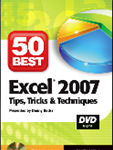A client asked for my help on this problem. How to create a Named Range in Excel for Non-Contiguous Cells. The problem is that Excel puts a 255 character limit on the “Refers to” portion of a Named Range. I struggled with this until I found the answer in one of my favorite resource books, “This isn’t s Excel, it’s Magic!” written by Microsoft MVP (Most Valued Professional) Bob Umlas.
Solve the Problem
- Select the non-contiguous cells that you want to name.
- Open up the Visual Basic Environment (Alt + F11 is a Keyboard Shortcut).
- In the VBE, open up the “Immediate Pane” – Ctrl + G is the Keyboard Shortcut.
- Finally, type Selection.Name = “MyLabels” in the Immediate Pane and press Enter. (Substitute the name you want for “MyLabels”).
When you return to Excel, you will see that you can use the Drop-down list in the Name Box or in the Excel 2007 Name Manager to select this range.
Amazing! Thanks Bob!
Additional tips
- Keyboard Shortcut F5 to open up the “Go To” Dialog Box. Select “Special” and choose “Constants – Text” to select the non-contiguous Labels that you want to name.
- Right-click the worksheet tab and select “View Code” top open up the VBE (Visual Basic Environment) window.
I invite you to watch and subscribe to my Video Podcast on iTunes – follow this link to “Danny Rocks Tips and Timesavers”
Learn How to “Master Excel in Minutes – Not Months!”
 How to Name a Large Range of Non-contiguous Cells in Excel [ 4:49 ] Play Now | Play in Popup | Download (788)
How to Name a Large Range of Non-contiguous Cells in Excel [ 4:49 ] Play Now | Play in Popup | Download (788)




How to Annotate Excel Worksheets with Comments and Images
Do you use “post-it” sticky notes to remind you how to do something? Do you ever lose your reminder notes? I know that I do! So that is why I like to annotate my Excel Worksheets with Comments – this way I have the notes properly located (in the worksheet) when I need them (to remember how to write a particular formula, etc.) the most!
In this lesson, I also show you how to add “pictures” inside your comments. This is a great tip for adding in a picture for a catalog or order form.
A question that I am frequently asked: “How do I print out my comments?” Watch this video to find out how to do this – there are a couple of “got’cha” steps involved.
The 50 Best Tips
Here are three ways to enter a new comment that is attached to a single cell:
You can edit your comments, re size the shape of your comments, hide your comments (only a “red triangle” shows in the cell until you hover near the cell), show your comments (individually or collectively), delete, clear and paste your comments. I cover each of these techniques in this video lesson. And more!
Watch this video in High Definition, Full Screen Mode on my YouTube Channel – DannyRocksExcels
Learn how to “Master Excel in Minutes – Not Months!”